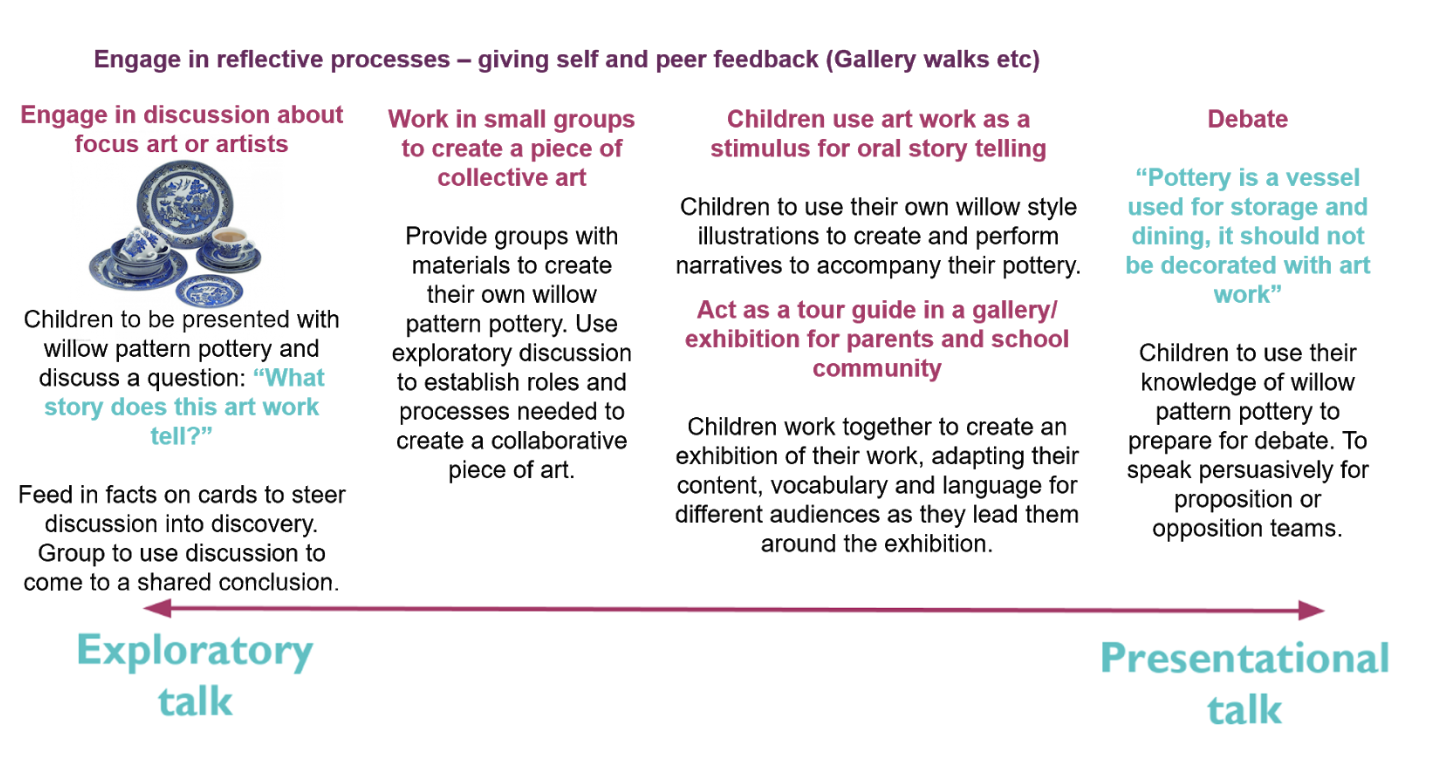Harley Bishop, Programme Lead at Voice 21, explores how art is a great opportunity for students to get talking.
Oracy and Art
At a time when many schools are feeling the pressure to squeeze the arts into their heavily packed schedules, it can be all too easy for teachers to prioritise a grammar lesson over setting up for an afternoon of painting or collage. When the pressure is on to smash floor targets in English and Maths, sketching and constructing may appear to pale in comparison to pie charts and percentages. However, there is more to an art lesson than glitter and glue.
Given a paintbrush or an oil pastel and set to work, children can often be heard in collaborative discussion whilst busily creating marks on their paper. Art projects allow children to provide running commentaries of their work as their ideas materialise on the paper in front of them. Children engaged in creative processes will often offer evaluative comments of their own work and those around them; using oral communication to verbalise their imaginative thoughts, suggesting improvements and giving praise, working through problems and fixing their mistakes. Whilst in the midst of creating a piece of art, children are constantly self evaluating – their talk with one another serves as a learning tool. Being comprised of focussed yet relaxed tasks, creative arts lessons are full of productive and reflective chatter, a natural source of language development. In order to capitalise on this and elevate oracy in the classroom, art projects should be carefully planned, with opportunities for both exploratory and presentational talk. Exploratory talk means learners trying out ideas, listening to other people and formulating their own understanding of a topic or concept. Presentational talk is instead using these formulated ideas, adapting language choices, content and manner to suit the needs of the audience (Barnes, 1992).
A well planned art project or unit of learning can include both types of talk. For instance, children might begin by being given a range of willow pattern pottery to explore with a question such as “What is the origin of this art work?” or “What story does this artwork tell?”. Pupils will engage in group discussion, looking for clues in the various pieces of pottery. The practitioner can begin to feed in facts on cards to steer the direction of the children’s discussion whilst allowing them to retain control of their talk. Gradually the children will come to a shared conclusion. Working together to create a piece of collective art, pupils will listen to others using communication to come to delegate tasks, agree priorities and solve conflicts. It is important that children are provided with models and scaffolds for this type of talk, through direct modelling from adults, talking stems and talk roles where appropriate. Challenging and subject specific vocabulary should be shared with pupils, for example technique, contour, sculpture or modernism. This ensures they are not only learning through talk, but also to talk. Once learners have created their pottery, they could use the illustrations as inspiration for oral storytelling, transitioning into a more presentational style of talk. They could prepare and perform their stories for groups of younger children and adapt their delivery accordingly. Instead they may choose to create an exhibition for the wider school community, acting as tour guides for visitors. Finally children could use their knowledge of the stories that willow pattern pottery tells to debate for or against the motion “Pottery is a vessel used for storage and dining, it should not be decorated with art work.” This unit of work flows from more exploratory talk to more presentational talk, but provides regular low stakes opportunities to practice both styles in rich, real life contexts.

Being involved in a creative project allows children to mediate between their inner imagination and their outer voice, providing opportunities for authentic talk. So in a setting where schools and teachers are under pressure to achieve results, what takeaways can we apply to the core curriculum? Creative art lessons are often conducted in a “workshop style” where children are engrossed in making, talking and collaborating with their peers and adults. Through contemplative and imaginative tasks, children have the opportunity to practice and refine their skills and trouble shoot through talk. This increases their mastery of techniques, both artistic and oral. Not only does this support the development of children’s talk in other areas of the curriculum, but it also provides a lesson structure which can easily be applied to other subjects. Looking at children’s talk through a creative lense allows practitioners to reflect on the type of talk happening in their classrooms. Extending the workshop style structure to other subjects allows for greater quality talk across the curriculum and this can only lead to greater results! More paint and more talk!
© 2022 Voice 21. Voice 21 is a registered charity in England and Wales. Charity number 1152672 | Company no. 08165798